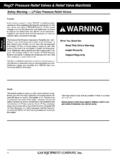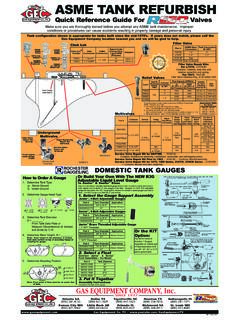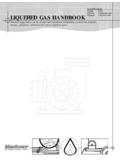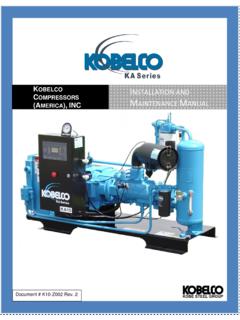Transcription of STEPS TO COMPRESSOR SELECTION & SIZING - Gas Equipment
1 04/99 CB-207 COMPRESSORSSTEPS TO COMPRESSOR SELECTION & SIZINGIU nderstand the Application What is the COMPRESSOR supposed to do?II Find Out the Details Gas, pressures, temperatures, capacities, Scope of Supply Who is to supply the motor, switchgear, piping, Size the CompressorV Select AccessoriesWhen all of the above has been done, this information can be combinedwith what is known about the customer's 'needs/desires' to generate asuccessful quotation. page 2 COMPRESSOR SIZING04/99 CB-207 STEP I - Understand the ApplicationBecome familiar with the big picture before getting into the details of the Form a clear, concise statement describing the purpose of the Many compressors operate at more than one condition.
2 Determine why and howoften the various conditions :This COMPRESSOR is to transfer liquid propane from railcars into a bulk storage the liquid has been transferred, the remaining vapors will be recovered. Thecompressor will operate year around, emptying about 2 railcars per COMPRESSOR will be used to evacuate a vessel at the end of a batch process. Itwill be used in a production facility that will perform 6 batch operations in a 16 THAT DETAILS LIKE PRESSURES, TEMPERATURES & FLOW RATES ARENOT NEEDED OR EVEN WANTED AT THIS STEP. page 3 COMPRESSOR SIZING04/99 CB-207 STEP II - Find Out the DetailsIn order to determine what type of COMPRESSOR system will be needed to accomplish thejob, a variety of detailed data will need to be a minimum, a precise understanding of the following data is required:Gas being handledSuction and Discharge PressureSite Elevation (or Local Barometric Pressure)Suction TemperatureCapacityIn addition the following items are needed to help make some subjective decisionswhen two or more options are available or in the SELECTION of various accessories.
3 'Normal' operating conditionsOther operating conditionsDuty CycleElectrical characteristics and area classificationAvailability of cooling waterHere is a sample problem that we will use to work through the STEPS needed to select acompressor and COMPRESSOR to be used to draw nitrogen off of a cryogenic storage tank and boostthe pressure to feed a number of plant processes. The flow requirement will varythroughout the 8 hour production day, but will average about 15 : Nitrogen at 5 psiDischarge:65 psiSite:1,000 ft. elevation, outdoors, Ambient of 0 to 100 FUtilities:460V/3ph/60hz, 80 F fresh water page 4 COMPRESSOR SIZING04/99 CB-207 STEP II - (Details) Gas Being HandledThe gas to be compressed must be precisely identified.
4 Once the gas has beenidentified the data for most gasses are readily available from published tables. If it isn't,the customer can often provide the needed Name - This may be presented as a chemical formula, a common name or a tradename. For example, dichlorodifluoromethane has a chemical formula of C Cl2 F2, aDuPont trade name of Freon 12, and a common name of refrigerant 12 or gas has a number of physical data that must be known. For most gasses, thesevalues are easily found if the gas has been precisely identified. (Terms like Freon, LPG,or even natural gas are too generic.)Data needed forMolecular WeightCritical Pressureeach gas."n" ValueCritical TemperatureGas Mixtures - A gas stream containing more than one gas may be presented with theMW, "n" value, and critical values already calculated for the mixture.
5 Alternately, thespecification may list the individual gasses and their percentage of the total. Thepercentages may be expressed on a volume (molar) or weight basis. The basis beingused must be known! Procedures for calculating average values for the total gasstream will be presented our example the gas is given as nitrogen from a cryogenic vessel. In this case thegas stream should be 100% N2 with virtually no measurable = Pressure = 493 psia"n" value = Temperature = 228 R page 5 COMPRESSOR SIZING04/99 CB-207 STEP II - (Details) Gas Being HandledMolecular Weight - The molecular weight of most gasses is fairly easy to find inpublished tables. For some gasses (particularly natural gas) the "specific gravity"may be given.
6 The molecular weight can easily be determined from the specificgravity: MW = SG ( ).R12 has a MW = and a SG = "n" Value - This is known as the specific heat ratio and is listed in many publishedtables. If the "n" value is not given, another value called the specific heat atconstant pressure (Cp) may be used to calculate the "n" value. The formula is:n =MW (Cp)MW (Cp) - Pressure (Pc) and Critical Temperature (Tc) - These two values are used tocalculate a value called compressibility (Z). Both Pc and Tc are published for mostgasses. Charts or a computer program are used to calculate the Z value from thecritical pressure and the critical temperature. For hand calculations or estimatingpurposes the compressibility factor may usually be ignored when SIZING Blackmercompressors.
7 The error introduced in most cases is small and the resultingcalculation will size the COMPRESSOR slightly larger than necessary. page 6 COMPRESSOR SIZING04/99 CB-207 STEP II - (Details) PressuresValues for pressure can also be a source of confusion since there are two distinctmethods of expressing pressure - "absolute pressure" and "gauge pressure". In order tosize a COMPRESSOR , the pressures must be expressed in "absolute" terms. Therelationship between the two systems is:PSIA = PSIG + Pamb Bar-a = Bar-g + PambPSIA pounds per square inch, absolutePSIG pounds per square inch, gaugePamblocal barometric pressure (psia or Bar-a)Bar-a Bars, absoluteBar-g Bars, gaugeThe use of the term "PSI" or "Bar" without an indication as to whether the value is agauge reading or an absolute measurement must be SUCTION PRESSUREThe pressure at the COMPRESSOR inlet expressed as psia (or Bar-a).
8 Pd DISCHARGE PRESSUREThe pressure at the COMPRESSOR discharge expressed as PSIA (or Bar-a).In the example, the suction and discharge pressures are given as 5 and 65 psirespectively. As mentioned above, we have to know whether he means 'psia' or 'psig'.In this case the customer advises that he meant 'psig'.These values will have to be converted to 'absolute' terms, but we can't do it until weknow the local barometric pressure. page 7 COMPRESSOR SIZING04/99 CB-207 STEP II - (Details) Site ElevationSite Elevation is used to determine the local Barometric Pressure, Pamb)Many of the formulas shown above require knowledge of the local barometric pressure,Pamb. If Pamb is not listed in the specifications it can easily be determined from the Pressure at Different AltitudesAltitude above sealevel, , above sealevel, , , , , , , , , , , , , , , , , , , , , , , , , , , , , , our example, the site data lists an elevation of 1,000 ft.
9 , so the local barometricpressure is psia. Now the absolute suction and discharge pressure can becalculated:Ps = 5 psig + psia = psiaPd = 65 psig + psia = psia page 8 COMPRESSOR SIZING04/99 CB-207 STEP II - (Details) Suction TemperatureTs SUCTION TEMPERATURET emperatures are also expressed as absolute ( R, K) or gauge ( F, C) values. Thecompressor suction temperature should be expressed in absolute terms ( R or K).Fortunately, most specifications are quite clear as to which scale is being used. R = F + 460 K = C + 273 RDegrees Rankine, an absolute value FDegrees Fahrenheit, a gauge value KDegrees Kelvin, an absolute value CDegrees Centigrade, a gauge valueIn the example, the suction temperature is not given.
10 We do know that the N2 is beingdrawn off a cryogenic vessel; this will be much colder than we will allow at thecompressor. Discussions with the customer indicates that a heat exchanger will beplaced between the storage vessel and the COMPRESSOR that will heat the gas stream toabout 50 F. Therefore:Ts = 50 F + 460 = 510 R page 9 COMPRESSOR SIZING04/99 CB-207 STEP II - (Details) CapacityProperly specifying the capacity required is often the most difficult aspect of SIZING acompressor. Many of the terms used to indicate a gas capacity are either vague or oftenmisunderstood. In addition many applications require the COMPRESSOR to operate under avariety of conditions resulting in a very wide range of size a COMPRESSOR the capacity must be stated as the volume it will occupy at thecompressor's suction.










